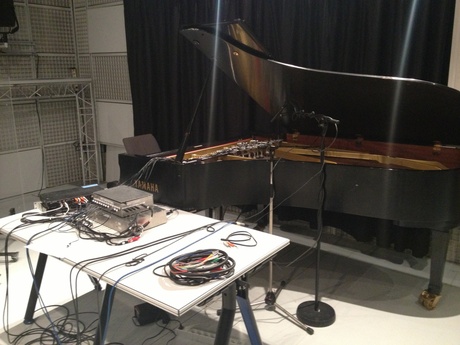Jusqu’ici, lorsque l’on voulait « augmenter » un piano, la démarche était sensiblement la même que pour tous les autres instruments augmentés, à cordes ou de percussions. C’est-à-dire qu’on fixait un ou plusieurs transducteurs (des petites membranes, qui vibrent comme celle des haut-parleurs) en des points stratégiques de la caisse de résonance. Ladite caisse servait alors d’enceinte et d’amplificateur naturels pour transmettre un discours électroacoustique, via les vibrations induites par le transducteur.
Ce dispositif a beaucoup d’avantages – mais il fait l’impasse sur le mode « naturel » d’émission et de transmission sonores du piano : c’est-à-dire la corde qui vibre, faisant à son tour vibrer la table d’harmonie puis toute la caisse. Certes, la corde peut être mise en vibration par le discours électronique – mais c’est un effet secondaire.
D’où l’idée qui a germé dans le cerveau des compositeurs Richard Causton et Per Bloland : augmenter le piano en transmettant directement aux cordes le signal électroacoustique. Pour cela, les deux compères « préparent » le piano électromagnétiquement.


De gauche à droite : Per Boland and Richard Causton
Le problème, en effet, est que l’on ne peut coller un transducteur directement sur les cordes du piano : cela les empêcherait de vibrer naturellement. Mais les cordes d’un piano sont en métal : elles sont donc susceptibles aux variations d’un champ magnétique. Très investi dans la recherche en informatique musicale, Per Bloland a mis au point un dispositif astucieux.
D’abord, pour que la corde choisie soit effectivement sensible aux variations d’un champ magnétique, il s’agit de la « polariser », c’est-à-dire d’attirer à un endroit précis plus de charges positives ou négatives qu’ailleurs. Un simple aimant placé à côté de la corde fait l’affaire (on met là à profit les propriétés de mobilité des électrons dans le métal de la corde). De l’autre côté, lui faisant face, on met cette fois un électroaimant (c’est-à-dire une bobine de fil électrique : c’est le passage de l’électricité dans le fil qui crée le champ magnétique, les variations du courant électrique entraînant des variations du champ magnétique) dont l’un des pôles est dirigé droit vers la corde1. Et le tour est joué. En principe du moins.
 Installation d'électroaimants sur un piano à queue
Installation d'électroaimants sur un piano à queue
Car les problèmes de mise au point ont été nombreux, comme le rappelle Per : « Quand on envoie un signal un peu trop fort, la bobine peut fondre sous l’effet de chaleur généré par l’électricité2. Le son produit est d’ailleurs magnifique ! Comme un cri tout doux. Mais après, c’est fini, la bobine est fichue, il faut la changer. On a donc appris de nos erreurs et on a équipé notre électroaimant d’un dissipateur de chaleur.»
« Il faut aussi veiller à ce que la corde, en vibrant, n’atteigne pas l’aimant, renchérit Richard. » Mais le résultat est saisissant : on peut jouer n’importe quel signal – même une voix : on a alors le sentiment que la corde « parle » !
« La différence majeure avec le piano augmenté que l’on connaît, c’est que le signal électroacoustique passe par un corps résonant naturel, et met à profit le schéma de rayonnement sonore de l’instrument : c’est presque magique ! Ensuite, la nature de la corde permet un contrôle fin et délicat. Dotée de sa fondamentale et de ses harmoniques naturels, elle agit également comme un filtre : c’est-à-dire, par exemple, que lorsque l’on envoie un signal qui correspond à la fréquence propre de la corde (un la pour une corde de la), le son obtenu va être plus fort. Mais cela veut aussi dire que si l’on envoie du « bruit », on va obtenir comme un son de caresse. On peut gérer des attaques de manière très raffinée (puisqu’on se passe du marteau), faire résonner des fréquences qui ne font pas partie des harmoniques de la corde, ou même produire des multiphoniques (en injectant une fréquence tandis qu’on joue la corde normalement, avec le marteau, faisant donc sonner sa fréquence propre). »


L'ensemble de la configuration sur un piano à queue
Jusqu’à présent, le système sur lequel les deux hommes travaillent (et pour lequel ils ont déjà composé quelques pièces) est constitué de 12 aimants, agissant sur 12 cordes (qu’ils peuvent choisir à leur guise, généralement en privilégiant une répartition chromatique). Il a été mis au point par Per Bloland, Steven Backer et Edgar Berdahl notamment au CCRMA (Center for Computer Research in Music and Acoustics de l’université de Stanford), et lors d’une première résidence à l’Ircam en 2013 pour en développer une interface de contrôle, via le module « Induction Connection » du logiciel Modalys.
L’objet de la résidence en recherche artistique qu’ils effectuent en ce moment à l’Ircam est d’élargir les possibilités du dispositif. Parmi les pistes envisagées, Per Bloland et Richard Causton aimeraient à terme l’étendre pour activer jusqu’à 24 cordes – voire équiper d’autres instruments à cordes. Ce qui suppose de nombreux enjeux comme d’adapter la puissance du dispositif à la taille de la corde (plus la corde est grave, plus elle est épaisse).
« Nous aimerions aussi explorer les possibilités d’équiper une même corde avec plusieurs électroaimants, ou étudier les manières de changer la qualité sonore de la corde, voire son timbre. »
Mais le premier et principal dossier sur lequel ils planchent, et pour lequel ils comptent sur l’aide des chercheurs de l’équipe S3AM de l’Ircam, c’est la mise au point d’un système de contrôle actif. Ce qui suppose au préalable d’ajouter au dispositif un capteur. Celui-ci, par le signal qu’il fournit en retour, permet alors d’analyser les modes de vibrations de la corde et de mieux comprendre ses réactions aux stimuli.
« Henri Boutin, avec lequel nous collaborons sur ce sujet, est un expert du contrôle actif, dit Per Bloland. Il a déjà travaillé sur un vibraphone et un métallophone, et nous espérons beaucoup de sa part, notamment en termes de rigueur et d’exhaustivité de la recherche. Mais aussi pour mettre ensuite au point l’interface de contrôle la plus complète et la plus efficace possible.» « Après tout, conclut Richard Causton, l’objectif final de toute cette affaire, c’est d’écrire de la musique pour ce nouvel instrument ! »
[1]Rappelons au passage qu’un haut-parleur n’est rien d’autre qu’une membrane entraînée par une bobine de fil électrique mise en mouvement par le champ magnétique variable qu’elle crée elle-même dans une enceinte aimantée.
[2]C’est l’effet Joule : effet thermique qui se produit lors du passage du courant électrique dans un conducteur – en l’occurrence avec le passage dans la bobine du signal électrique correspondant au son.




